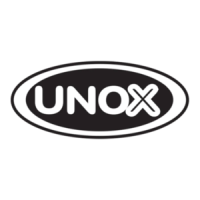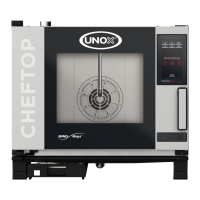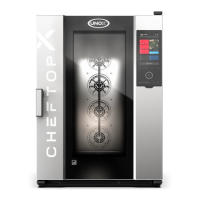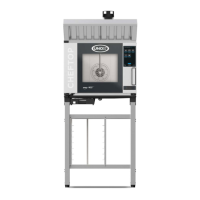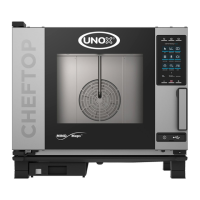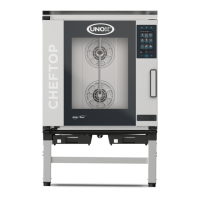Do you have a question about the Unox ChefTop Gas and is the answer not in the manual?
Read manual for safe installation, operation, and maintenance information.
Clean oven with warm water and detergent before first use, then rinse thoroughly.
Advised daily cleaning of the chamber and external parts using appropriate methods.
Description of the touch-sensitive control board, its layout, and operation.
Instructions for powering the control board on/off and the chamber light functionality.
Guide to composing cooking programs using 4 steps and passing between them.
Details on setting core temperature, chamber temperature, climate, and Delta T.
Procedure for initiating, pausing, and stopping cooking cycles via the control panel.
Setting, saving, and recalling up to 70 cooking programs.
Using pre-set washing programs and calling up saved cooking programs.
Using the 'COOL' program and selecting predefined automatic cooking cycles.
Programs for Pizza, Bread, Pastry, Poultry, and Fries.
Programs for Regeneration, Vacuum, Steam, Slow, Roast, and Grill cooking.
Managing multiple connected UNOX appliances with a single control panel.
How time, cavity temperature, and hot dry air affect cooking results.
Principles of cooking with steam and combined air-steam methods.
Advice on preheating, tray spacing, food quantity, and core probe placement.
Details on convection, convection with humidity, and dry air convection baking.
Explanation of the system that extracts humidity for crispy results.
Using core probe with chamber temperature and Delta T for precise cooking.
Functions of the USB interface kit for program management and diagnostics.
Checking combustion, burner surface, heat exchangers, and baffles.
Step-by-step guide for replacing the oven's internal lamp.
Procedures for resetting the safety thermostat and lighter device.
Instructions for checking and replacing the flame control fuse.
Steps to take for turning off the appliance in case of malfunction.
Explanation of oven error messages (EF1-EF7) and troubleshooting steps.
List of blast chiller error messages (EA1-EA5) with causes and remedies.
Troubleshooting error messages for holding cabinets (EL1-EL3) and hoods (EC1-EC2).
Error messages (EO1-EO5) for the osmosis system and their resolutions.
All installation operations must be by qualified personnel; preliminary checks required.
Verifying site dimensions, connections, and preparing for appliance placement.
Instructions for removing protective film and any adhesive residue from the appliance.
Guidelines for placing the appliance, ensuring adequate clearance and stability.
Connection must follow local regulations; voltage and frequency checks are vital.
Connecting the oven via the provided cable and plug to a suitable outlet.
Ensuring the appliance is part of an equipotential system for safety.
Check gas type data; install interception cock; use approved pipes.
Connecting to the gas main using flexible/non-flexible pipes and an interception cock.
Procedure for replacing nozzles and adjusting primary air for different gas types.
Verifying nominal thermal power and connection pressure values.
Measuring service pipe pressure using a manometer.
Checking gas circuit seal and burner flame appearance.
Technician informs user; test oven startup, checking for air bubbles.
Connecting water supply with filter/valve; water hardness requirements.
Connecting waste outlet pipe and ensuring proper cooking chamber exhaust.
Details on connecting the waste outlet pipe and venting chamber exhaust.
Warning regarding internal glass emissivity and correct placement during replacement.
Using the UNOX stacking kit to ensure correct distance between stacked ovens.
Read manual for safe installation, operation, and maintenance information.
Clean oven with warm water and detergent before first use, then rinse thoroughly.
Advised daily cleaning of the chamber and external parts using appropriate methods.
Description of the touch-sensitive control board, its layout, and operation.
Instructions for powering the control board on/off and the chamber light functionality.
Guide to composing cooking programs using 4 steps and passing between them.
Details on setting core temperature, chamber temperature, climate, and Delta T.
Procedure for initiating, pausing, and stopping cooking cycles via the control panel.
Setting, saving, and recalling up to 70 cooking programs.
Using pre-set washing programs and calling up saved cooking programs.
Using the 'COOL' program and selecting predefined automatic cooking cycles.
Programs for Pizza, Bread, Pastry, Poultry, and Fries.
Programs for Regeneration, Vacuum, Steam, Slow, Roast, and Grill cooking.
Managing multiple connected UNOX appliances with a single control panel.
How time, cavity temperature, and hot dry air affect cooking results.
Principles of cooking with steam and combined air-steam methods.
Advice on preheating, tray spacing, food quantity, and core probe placement.
Details on convection, convection with humidity, and dry air convection baking.
Explanation of the system that extracts humidity for crispy results.
Using core probe with chamber temperature and Delta T for precise cooking.
Functions of the USB interface kit for program management and diagnostics.
Checking combustion, burner surface, heat exchangers, and baffles.
Step-by-step guide for replacing the oven's internal lamp.
Procedures for resetting the safety thermostat and lighter device.
Instructions for checking and replacing the flame control fuse.
Steps to take for turning off the appliance in case of malfunction.
Explanation of oven error messages (EF1-EF7) and troubleshooting steps.
List of blast chiller error messages (EA1-EA5) with causes and remedies.
Troubleshooting error messages for holding cabinets (EL1-EL3) and hoods (EC1-EC2).
Error messages (EO1-EO5) for the osmosis system and their resolutions.
All installation operations must be by qualified personnel; preliminary checks required.
Verifying site dimensions, connections, and preparing for appliance placement.
Instructions for removing protective film and any adhesive residue from the appliance.
Guidelines for placing the appliance, ensuring adequate clearance and stability.
Connection must follow local regulations; voltage and frequency checks are vital.
Connecting the oven via the provided cable and plug to a suitable outlet.
Ensuring the appliance is part of an equipotential system for safety.
Check gas type data; install interception cock; use approved pipes.
Connecting to the gas main using flexible/non-flexible pipes and an interception cock.
Procedure for replacing nozzles and adjusting primary air for different gas types.
Verifying nominal thermal power and connection pressure values.
Measuring service pipe pressure using a manometer.
Checking gas circuit seal and burner flame appearance.
Technician informs user; test oven startup, checking for air bubbles.
Connecting water supply with filter/valve; water hardness requirements.
Connecting waste outlet pipe and ensuring proper cooking chamber exhaust.
Details on connecting the waste outlet pipe and venting chamber exhaust.
Warning regarding internal glass emissivity and correct placement during replacement.
Using the UNOX stacking kit to ensure correct distance between stacked ovens.
| Construction Material | Stainless Steel |
|---|---|
| Fuel Type | Gas |
| Capacity | Varies by model |
| Temperature Range | 50°C - 300°C |
| Weight | Varies by model |
| Dimensions (WxDxH) | Varies by model |
